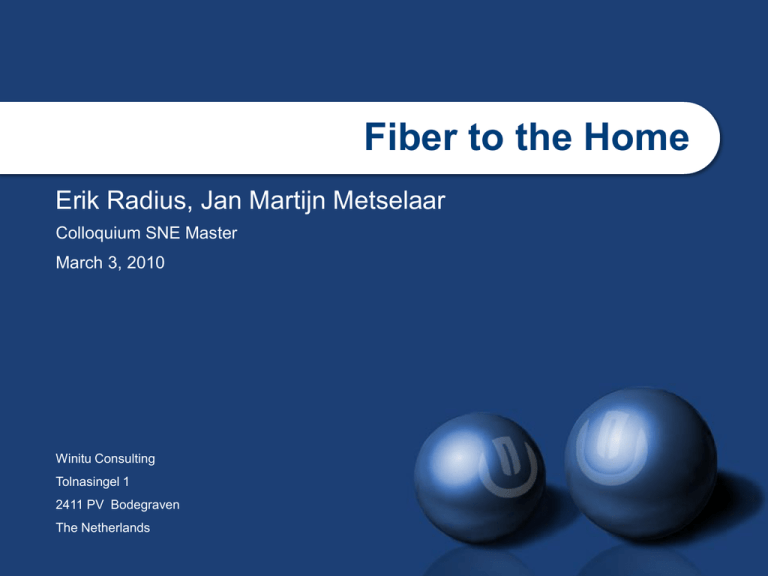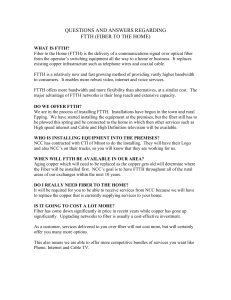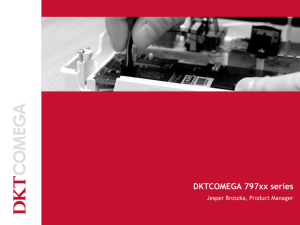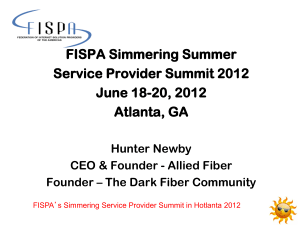Fiber to the Home
advertisement

Fiber to the Home Erik Radius, Jan Martijn Metselaar Colloquium SNE Master March 3, 2010 Winitu Consulting Tolnasingel 1 2411 PV Bodegraven The Netherlands slide Agenda 1 Introduction 2 Fiber to the Home – technology 3 Broadband networks – Network Architecture 4 Discussion! slide 2 Agenda Who are we? Winitu Consulting is an experienced consultancy company providing knowledge of data- and telecommunication, IT and business process management. Winitu’s customer potfolio ranges from large service providers to small enterprises in both profit and non-profit sectors. Winitu consultants are experienced in design, implementation, optimisation and management of complex networks, IT and processes. slide 3 Introduction Winitu Consulting What do we do? – Winitu Portfolio Strategic / Tactical Innovation • Technical business • New technology consultancy Operational Excellence Development • Process consultancy • Hands-on experience • Problem solving Auditing Network design and Business Modelling implementation Project Management IT design and implementation Proces design and Network optimisation implementation Network and IT testing IT and network management Service and business development slide 4 Introduction Winitu Consulting Organisation WinITu Gold BV 100% 100% Winitu Consulting BV Winitu Communications BV 100% 40% igilde BV Infodation About the Winitu Group: WinITu Gold was founded January 2000 Winitu Communications is a, OPTA registered, (wholesale) unified communications provider igilde is a full service IT service provider focused on network technology Infodation is a software development company using remote sourcing in Vietnam slide 5 Introduction Winitu Consulting Introduction of the speakers of today Erik Radius Jan Martijn Metselaar slide 6 Introduction Agenda 1 Introduction 2 Fiber to the Home – technology 3 Broadband networks – Network Architecture 4 Discussion! slide 7 Agenda FTTH technology: a closer look at optics Optical fiber is a compact, low-loss carrier for broadband signals Optical fiber consists of 3 main parts 1: glass core 2: glass cladding 3: plastic buffer coating slide 8 FTTH technology Optical fiber inner workings Optical signal is contained within the fiber Higher index of refraction in core than in cladding Total internal reflection at the core/cladding boundary slide 9 FTTH technology Multimode versus Singlemode (1) Multimode ‘Bigger’ core: 50 / 62,5mm Multiple optical modes supported/transmitted Bandwidth*distance product is limited Only suitable for shorter distances (<1km) slide 10 FTTH technology Multimode versus Singlemode (2) Singlemode Small core: 9mm 1 optical mode is supported/transmitted Signal may be carried over very large distance More information online, e.g. http://www.rp-photonics.com/fibers.html slide 11 FTTH technology Transmitter & receiver Optical fiber is only a passive waveguide Active components at the end points: Signal source: laser diode Receiver: photo diode (Amplitude)modulation of the data stream Light signal is the ‘carrier’ wave Both digital and analog transmission possible slide 12 FTTH technology Signal loss in optical fiber is wavelength dependent slide 13 Power budget 14 source: http://www.thefoa.org/ slide 14 Optical power budget Fiber link design: what is involved Fiber type (single mode? multi mode?) Fiber length (km) Licht source: output power (dBm) Detector: receiver sensitivity (dBm) Elements in the link that cause additional signal loss Fiber link budget or optical power budget the amount of light available to make a fiber optic connection Provides the maximum distance with the available optics Take a minimum of 3dB margin into account slide 15 power budget Optical power budget: case #1 Laser power: Fiber attenuation: Fiber length: Receiver sensitivity: -7 0,4 20 -29 dBm dB per kilometer km dBm Splice loss: 0,1 dB (max.) Connector loss: 0,5 dB (max.) # of connectors: 2 # of splices: 4 Calculate Link budget: laser power – receiver sensitivity Calculate Margin: laser power – receiver sensitivity – [link losses] slide 16 power budget Optical power budget: case #2 Laser power: Fiber attenuation: Fiber length: Receiver sensitivity: +1 dBm 0,25 dB per kilometer 40 -12 km dBm Splice loss: 0,1 dB (max.) Connector loss: 0,5 dB (max.) # of connectors: 4 # of splices: 8 Calculate Link Budget: laser power – receiver sensitivity Calculate Margin: laser power – receiver sensitivity – [link losses] slide 17 power budget Pros and cons of optical fiber Question for you all... Give me 3 advantages of optical fiber over metallic wiring ... and ... 3 disadvantages slide 18 FTTH technology Fiber networks Transport networks layers Core (+ international) network Metro(politan) network Access network Access network for telecom/cableTV partial fiber Telecom Optical fiber up to central office Copper connection into the home Cable TV Optical fiber up to street cabinet coax connection into the home slide 19 FTTH technology International networks (submarine cable systems) slide 20 National networks source: GIGAport website slide 21 City networks (metro rings) source GIGAport website slide 22 Fiber penetration in the access network Fiber…. to the Node Central office, >300m to the Curb/Cabinet Straatkast, <300m to the Building/Basement Multi-storey buildings to the Home into the ‘meterkast’ http://upload.wikimedia.org/wikipedia/commons/3/32/FTTX.png slide 23 FTTH technology FTTH cabling concept Access network branches off multiple times between central office and the home Installed: underground or above ground (!) slide 24 FTTH technology Fiber installation above ground: example FTTH in Romenia (Bucharest) slide 25 FTTH technology Underground installation Several underground deployment methods available 1: modular tubes; insert fiber as needed (blown fiber) 2: fiber inside rugged cable (buried fiber) Blown fiber explained in more depth slide 26 FTTH technology Miniduct system for access network 1, 7, 12, 24 thin tubes in a rugged outdoor cable Branching off one or multiple tubes is relatively simple slide 27 FTTH technologie Fiber in mini duct Install thin cable into duct using airflow slide 28 FTTH technologie Fiber connection in the home Example optical fiber network terminal Services for end user: Internet (Analogue) television Phone Most often installed in the utility cabinet (‘meterkast’) slide 29 Fiber connection in the home Fiber, the movie FTTH installation in a Dutch neighborhood Blown fiber concept using branching off of individual tubes for house connections In the home: miniduct in the utility cabinet Installation of network terminal Testing & activation slide 30 FTTH technologie Watch the movie … movie link is on your desktop somewhere slide 31 Fiber architectures (1): Point-to-point point-to-point 1 on 1 fiber connection between Central office and Home POP slide 32 FTTH technology Fiber architectures (2): PON point-to-multipoint (PON: passive optical network) optical splitter in the link, to send same signal to multiple end points POP slide 33 FTTH technology PON: shared medium slide 34 Point-to-point versus PON PON popular with telcos USA Japan Australia ‘closed business/network model’ Point-to-point mostly popular in Europe Scandinavia Netherlands, France, etc ‘open network model’ slide 35 FTTH technology Bidirectional data transmission popular in FTTH Single fiber bidirectional for data Different signal wavelengths for up vs down 1500nm downlink 1310nm uplink Reason? Less fiber needed in the field fiber management is expensive Space in the Central Office is scarce slide 36 FTTH technology POP fiber management slide 37 FTTH technologie Transport of services 3 services in the access network Internet Voice/telephony Television Various ways to realise this... e.g. Internet: via data fiber (IP) Voice: via data fiber (VoIP) Television: via CATV fiber (overlay network) or via IP slide 38 FTTH technology Agenda 1 Introduction 2 Fiber to the Home – technology 3 Broadband networks – Network Architecture 4 Discussion! slide 39 Agenda Quizzz Dual play, Triple play, Multi play IP all the way! But what does the end-user care? slide 40 Broadband services Current broadband services over FTTH networks Internet access Unicast IP (Duh…) Television IP unicast for video-on-demand IP multicast for broadcast television (the ‘default’ package of 50 channels) Telephony SIP signaling, RTP for transport slide 41 Broadband services Current broadband services over FTTH networks Nice those triple play services, but how do you get the content to the subscribers? Smart network architecture… slide 42 Broadband services Network Architecture – Layered model Access Lots of individual connections Focus on physical aggregation of lines Security Distribution Connection towards access layer Focus on logical aggregation of connections Route summarization Core Connection towards the distribution layer Focus on traffic volume No identification of individual connections slide 43 Broadband services Network Architecture – Layered model Service provider 1 Service provider 2 Core network core metro access slide 44 Discussie / Quizzz The how and why of current broadband networks Protocols? Speeds? Possibilities? Restrictions? slide 45 Broadband services Network Architecture – Ethernet as uniform transport protocol Leased line ATM Frame Relay X.25 Ethernet PPP Ethernet Packet over Sonet (POS) SONET SDH STM-1, 4, 16 slide 46 Broadband services Network structure – Domain separation Access Distribution / Core Core ISP 1 NT backbone WWW ISP 2 ISP 3 subscriber domain • Operator domain PSTN/ISDN service provider domain “Wholesale” model: operator delivers network facilities to different content and service providers. slide 47 Network Architecture – Access: connection model How is the connection between subscriber and network realized? Point-to-Point Protocol (PPP) Ethernet Bridging “DHCP model” IP over PPP over Ethernet IP over Ethernet PPP session from the modem IP address assigment through into the distribution layer IP address assignment in PPP session setup via RADIUS ‘connection oriented’ Multiple PPP sessions for QoS DHCP ‘connection less’ QoS via Ethernet Class of service guarantees slide 48 Broadband services Network Architecture – Core: MPLS VPN Ethernet Bridging NT MPLS VPN VPN ISP SP 11 VPN Distributie / Core apparatuur VPN ISP SP 22 backbone ISP 1 ISP 2 ISP 3 VPN ISP SP 33 City PoP subscriber domain Operator domain service provider domain slide 49 Network Architecture – Core Network MPLS (Multi Protocol Label Switching) Support for VPNs Traffic Engineering (used for fast reroute and ip multicast traffic) Ethernet transport over MPLS IP Routing IGP For distributing ‘next-hop’ routing information OSPF or IS-IS M-BGP For distributing IPv4 prefixes slide 50 Broadband services Network Architecture – MPLS primer: labels IP packet L1 IP packet L2 IP packet L3 IP packet IP packet • • • • • Label Switched Router (LSR) MPLS enabled router Forwarding based on Labels, forwarding control separated from forwarding plane Labels are distributed via Label Distributie Protocol (LDP) LDP hello packets are UDP and transported via broadcast of multicast Multiple labels (stack) per packet possible (note that MTU must be large enough!) slide 51 Network Architecture – MPLS primer: forwarding Routing information exchange Control plane inside a node with other routers IP routing protocols IP routing table Label information Base (LIB) MPLS IP routing control Label binding exchange with different routers Data plane inside a node Forwarding Information Base (FIB) Label Forwarding information Base (LFIB) slide 52 Complexity Network Architecture – Increasing complexity Triple play Dual play Single play Multiplay slide 53 Broadband services Quizzz What about Quality of Service? What about Security? slide 54 Broadband services Network Architecture – Quality of Service Core network QoS only relevant if congestion can occur Used to be irrelevant in broadband networks as bandwidth was plenty. FTTH and Docsis3 has changed this. QoS policy of most providers was: “upgrade capacity”. Currently large providers are running into technological limits: 10GE is not fast enough and 100GE is not yet there! Cost for service providers is increasing rapidly Traffic is becoming more symmetrical slide 55 Broadband services Network Architecture – Quality of Service Access networks Multi-play services all use the same connection Voice traffic needs to be protected Video needs to get enough bandwidth (otherwise you’ll see blocks) Video and voice need protection from general internet traffic(especially P2P and news traffic) slide 56 Broadband services Network Architecture – Quality of Service QoS enforcement QoS parameters downstream traffic On incoming traffic NT backbone ISP 2 QoS transparent QoS parameters upstream traffic • IP QoS: precedence bits, diffserv • Ethernet QoS: Class of Service (priority bit in vlan header) • MPLS QoS: Exp. bits slide 57 Network Architecture – Security slide 58 Security Network Architecture – Security Network Access to network elements Access to network management systems Protocols “Security by obscurity” Control plane protection Services platform Policy: every service is responsible for it’s own platform Where possible network security can provide additional protection Separate users Spoofing filters User isolation Protocol filters (note that new OS like Windows Vista and 7 bring new challenges, like IPv6 default enabled). slide 59 Security Network Architecture – Security Attack Vectors ARP flood attack, plus spoofing DHCP flood attack MAC flood attack, plus spoofing IGMP flood attack IPv4 broadcast flood attacks IPv4 unicast flood attack TTL=1 attack IP options attack IPv6 MLD … some others. Focused on the control plane of the routers and switches in the network. Most are denial of service attacks, but some can be used for a ‘man-in-the-middle’ attack. slide 60 Security Network Architecture – Security (DHCP) Spoofing filters Arp filtering Security by obscurity (that which is not reachable is secure) NT backbone ISP 2 Reverse path check NT configuration Security force configuration Private vlan’s vlan filtering from a central server slide 61 Network Architecture – FTTH networks Security toolbox DHCP snooping Dynamic Arp Inspection PFC based special case VACL Layer-2 filtering: Hardware limiters -Allow ethertypes 0x800 and 0x806 Private VLAN -Broadcast ARP filtering -Multicast filtering -Broadcast redirection NT Multicast route limit Control plane policing uRPF STP filtering Ethertype filtering: Ip local proxy-arp ARP rate-limiting - 0x800 0x806 (IP & ARP) PIM neighbor filtering DHCP rate-limiting IGMP group filtering IGMP group limiting UUFB UMFB Port-security IPSG Storm-control slide 62 Quizzz Network management? Why does that seem to be so difficult for most Service Providers? slide 63 Broadband services Network IT - Network Management tools MRTG NAGIOS HP Openview slide 64 Broadband services Network IT - Provisioning We like “zero touch” , “flow through” provisioning. Service providers would like to focus on “exception management” only… Bullshit or …? slide 65 Broadband services Network IT – Provisioning The success of network provisioning and order management is correct and complete information: Orders Connections Automation is the key, every manual action increases the chance of mistakes slide 66 Broadband services Network and IT – Systems Exploitanten Customer Services Service Providers Beschikbaarheid Incident Locatie, apparatuur & verbindingen Na-aansluiting Back-office Order systeem Bouw & Field Operations Incident Management Systeem Communicatie bus Uitbreidingen Network Inventory Looking glass Master Provisioning System BECS BECS Provisioning Packetfront Packetfront FTTH Netwerk FTTH Netwerk Packetfront Packetfront FTTH Netwerk FTTH Netwerk Leverancier XYZ Leverancier XYZ FTTH Netwerk FTTH Netwerk slide 67 Agenda 1 Introduction 2 Fiber to the Home – technology 3 Broadband networks – Network Architecture 4 Discussion! slide 68 Agenda That’s all for now! Questions? Don’t hesitate to send us an email: erik @ winitu.com janmartijn @ winitu.com slide 69 questions







